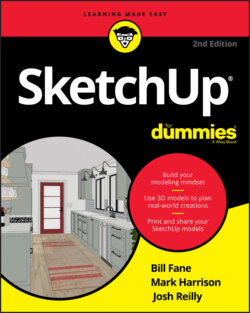Читать книгу SketchUp For Dummies - Mark Harrison - Страница 38
Facing the facts about faces
ОглавлениеFaces are surfaces. If you think of SketchUp models as being made of toothpicks and paper (which they kind of are), faces are basically the paper. Here’s what you need to know about faces:
You can’t have faces without edges. To have a face, you need to have at least three coplanar (on the same plane) edges that are connected. In other words, a face is defined by the edges that surround it, and those edges all have to be on the same flat plane. Because you need at least three straight lines to make a closed shape, faces must have at least three sides. There’s no limit to the number of sides a SketchUp face can have, though. Figure 3-4 shows how faces can disappear when you erase an edge that defines one or more faces. We started with the model on the left and deleted the edge that completed both the top face and one of the side faces. The result, shown on the right, is that both of those faces disappeared.
Faces are always flat. In SketchUp, even surfaces that look curved are made of multiple, flat faces. In the model shown in Figure 3-5, what look like organically shaped surfaces (on the left) are really just lots of smaller faces (on the right). Think of the many small mirrors that make up the surface of a nightclub disco ball. To make a bunch of flat faces look like one big, curvy surface, the edges between them are smoothed. You find out about smoothing edges in Chapter 6.
Just like edges, faces don’t have any thickness. If faces are a lot like pieces of paper, they’re infinitely thin pieces of paper; they don’t have any thickness. To make a thick surface (say, a 6-inch-thick wall), you need to use two faces side by side. In SketchUp, even a solid concrete wall will be hollow.
FIGURE 3-4: You need at least three coplanar edges to make a face.
FIGURE 3-5: All faces are flat, even the ones that make up larger, curvy surfaces.
